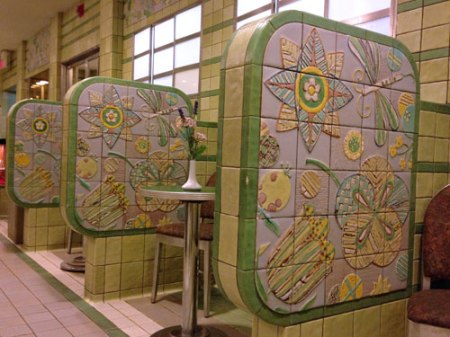The Cincinnati Union Terminal was designed by Alfred Fellheimer and Steward Wagner, with design consultant Paul Phillipe Cret being responsible for the dramatic Art Deco aesthetic inside and out. Ground was broken in 1929 just before the stock market crash, and the facility opened in 1933.
The terminal unified all area train stations under its roof to expedite travel and included a bookstore, bank, toy store, newsstands, men’s store, women’s clothing store, restaurants, and an air-conditioned movie theater. Designed for up to 17,000 passengers daily, it serviced 34,000 per day during WWII.
This streamlined sign greets you as you approach:
In front of the building is a lovely fountain, which is turned off during the winter. I actually really like seeing the stair-stepped levels that lead your eye directly to the magnificent façade:
Sometimes I encounter something that’s clearly not for sale and immediately put it on my mental wish list, like this clock:
Bas relief by Maxfield Keck:
At 106 feet tall and 180 feet wide, the rotunda was the largest half-dome in the world until the Sydney Opera House stole that honor. This is still the largest half-dome in the Western Hemisphere, and it’s so massive that I didn’t even attempt to capture the whole thing, just a pretty detail of the ceiling:
Sometimes it’s fun to be a tourist in your own city so, although I’d been here before, I decided to take a free docent-led tour on a recent afternoon [it’s supposed to be 45 minutes, but mine was very detailed and lasted 1 1/2 hours]. Aside from learning a lot of history and little-known facts, the tour provides access to areas not normally open to the public, including the rotunda’s mezzanine, which is a great vantage point for admiring the glass mosaic murals:
Designed by Winold Reiss and fabricated by the Ravenna Tile Company, 23 murals throughout the building depict the history of the US [shown above], with a specific focus on Cincinnati [shown below] and even a couple of panels devoted to the building of this structure. As you move through the rotunda, you notice that some of the mural details have a silver sheen:
Back on the main floor of the rotunda, the awesome lettering and Art Deco details just don’t stop!
The Rookwood Tea Room [now the Rookwood Ice Cream Parlor] was designed by William E. Hentschel as one of the last architectural tile installations the company would execute before declaring bankruptcy [Rookwood Pottery has now been reborn]. The room features floor-to-ceiling tile and tile booths in shades of green and mauve.
The current Amtrak waiting room was once the men’s lounge, and the walls are covered in wood veneer depicting a train motif:
Pierre Bourdelle designed the carved linoleum wall panels for the women’s restroom vestibule, featuring jungle-type scenes:
The old formal dining room has a balcony for the band, and Bourdelle painted this oil-on-canvas ceiling mural, which depicts a colorful, flipped map of Cincinnati:
The highlight of the tour is a visit to the executive suite [not open to the public], starting with the built-in filing cabinets and Pueblo Deco walls in the secretary’s office:
The president’s office is round with wood veneer paneling, including a built-in clock that’s a replica of Union Terminal:
The desk is a half-circle and fits perfectly in the middle of a pieced cork floor with a round motif:
So cool: a wood veneer map of the US and Cuba [included because it was a popular vacation destination at the time]:
Seating in the board room features an integrated ashtray and humidor:
When we first moved to Cincinnati, for some reason we attended a meeting of the Cincinnati Railroad Club. Aside from the stress of having to stand up and introduce ourselves to a room full of retired railroad workers and their spouses, it was a fascinating evening filled with stories, slides and a video of a train journey. Attending a meeting was also the only way to access Tower A at the time.
Luckily for you, Tower A is now open to the public and includes displays of memorabilia and a small gift shop, in addition to sweeping views of the West Side and the train yard below:
When the indicator lights are on, the track diagram is basically the coolest thing ever. Without the lights, it’s still pretty cool:
Union Terminal is one of my must-see sights in Cincinnati, and both Tower A and the docent tour are free [details here]. The building also houses several museums and an OMNIMAX Theater, but even just the free stuff can occupy you for at least a couple of hours.























Pingback: VisuaLingual Promotion for CSX | Visualingual
Pingback: Elsewhere | Visualingual
Pingback: The Hands That Built This City by Jenny Ustick | Visualingual
Pingback: Looking Back: Best VL Posts of 2013 | Visualingual
Pingback: Elsewhere | Visualingual
Pingback: Elsewhere | Visualingual
Pingback: Elsewhere | Visualingual
Pingback: The Migration of Tradition by Tina Westerkamp | Visualingual
Pingback: Monroe Building by Holabird & Roche | Visualingual
Pingback: Indianapolis Central Library by Paul Philippe Cret with Zantzinger, Borie & Medary | Visualingual
Pingback: Elsewhere | Visualingual